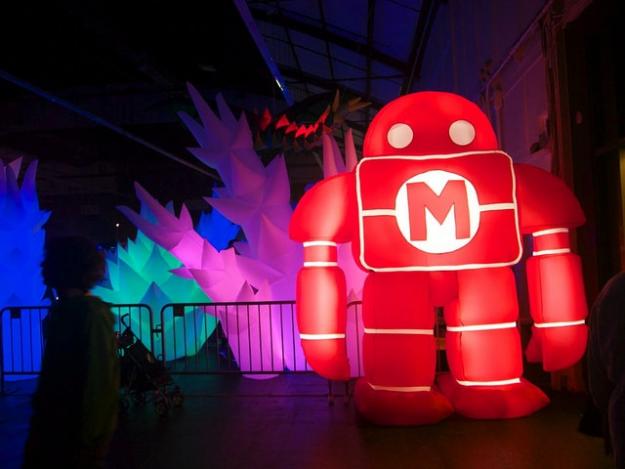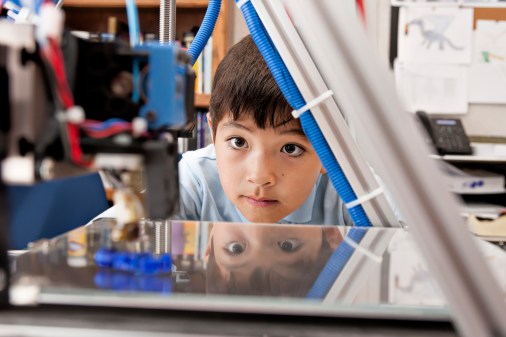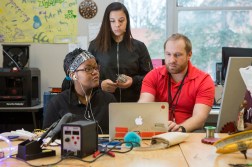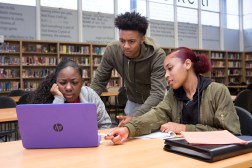Tech enthusiasts trek to Washington for National Week of Making

Robbie Munsey noticed a trend when he transformed an old storage room into a glass-walled makerspace in the Virginia middle school where he used to teach.
Munsey, now lead coach for STEM education for Albemarle County Public Schools, saw that his students were memorizing content for tests but forgetting the material almost instantly. So he came up with a solution: He persuaded his principal to build a makerspace, now aptly coined “The Shark Tank” by students and teachers.
“We’re trying to create a more authentic, hands-on learning experience for our kids so they can learn through doing and not just by doing worksheets,” the former science and math teacher said. “Our goal is to develop spaces where kids can take ownership of their learning.”
This idea of “making,” allowing students to become active learners through using machinery, hardware and technology like 3-D printers, has attracted attention from educators throughout the country, in places like museums, colleges and K-12 schools. What started as a small White House initiative launched by President Barack Obama about two years ago has now turned into a whole week of festivities dubbed the National Week of Making, which kicked off Friday and runs through Thursday.
It all took off when Obama hosted the first White House Maker Faire in June 2014. The festival was held to allow kids, entrepreneurs and anyone else interested to demonstrate how they have used their science, technology, engineering and math skills to make new inventions, White House officials say.
Now, more than 1,400 schools representing nearly 1 million students from all 50 states have signed the Maker Promise, a presidential campaign to grant more students the opportunity to make, nonprofit Maker Ed announced Friday. The organization is pushing educators to engage youth through maker activities.
“We are invigorated by the resounding response from school leaders, and see it as a sign that schools, educators and their learners are inspired by the movement to make, create and design,” Maker Ed’s Executive Director, Trey Lathe, said in an interview. “We are honored and thrilled to continue supporting educators as they bring maker-centered learning into their classrooms.”
Maker-centered learning is part of the the transition from traditional 20th century education, featuring sewing machines and woodshop classes, to the technology-tinged schooling of today, Albemarle County Public Schools superintendent Pam Moran said.
The 10-year veteran said in an interview that she believes “kids see how making gives them not just a voice and an agency of learning, but also a way to benefit the community and help others.”
In her district, a group of students used making to help a student with special needs. The girl found it challenging to eat because of her disability, so the kids put their heads together to make a customized spoon that made eating easier for her.
Moran was proud of the dedication her kids exhibited because they had to try multiple approaches until they figured out the perfect dimensions for the spoon.
“We want our kids to know they can do anything they want to accomplish because, with making, they are self-determined learners,” Moran said.
Some of Moran’s students participated in the Maker Faire in Washington last weekend. The group demonstrated some of its most prized work along with Maker Ed on Saturday as part of Design Launch Make Academy, a high school credit-earning summer program in Albemarle.
Maker Faire was started in the San Francisco Bay Area in 2006 by founder and CEO Dale Dougherty and co-creator Sherry Huss as a family-friendly festival that is now internationally recognized. The two are also the creators of Maker Media, which publishes a magazine called MAKE.
“We believed it was important to pull makers together and give them a showcase to present what they do and celebrate making,” Huss said in an interview.
The vice president of Maker Media also added that Maker Faire has exceeded its initial goals. Today, Maker Media has global partners and distribution in parts of Asia and Europe. Last year, more than 1.2 million people attended a Maker Faire in person, Maker Media officials say.
They realized in 2010 “that what [they] were doing was a catalyst and at the heart of the maker movement,” and broke off from their parent company O’Reilly Media in 2013, Huss told EdScoop.
She revealed that the company’s largest growth area is in education. This comes as technology is increasingly incorporated into schoolwork, and classrooms are now home to tools like laser cutters and 3D printers, common staples of makerspaces.
Experts and school officials say this is the future of education.
At an urban high school called Workshop School, based in Philadelphia, kids get to work in makerspaces everyday, principal Simon Hauger said.
The school includes both “old and new school” makerspaces. He said kids have access to 3D printers, laser cutters, a Shopbot CNC Router and plasma cutter, welders, and metal and wood working tools.
Hauger, who has a background in engineering, brought freshmen and sophomores to the inaugural White House Maker Faire.
“We were one of the five groups invited to the Oval Office at the first White House Maker Faire to feature one of the things we made,” said Hauger, who added proudly that they also got to meet the president.
The group of students made a Factory Five Racing 818 biodiesel sports car, in which Obama sat and almost tried for a spin. The car can go up to 100 mph.
Hauger doesn’t need it to be the National Week of Making to try new methods of learning.
In Workshop’s English class, students recorded TED Talks and posted them to their individual websites, which they use as digital portfolios to exhibit their maker work. Meanwhile in science class, ninth graders learn about electricity and circuitry by designing and building lamps from scratch, students have also made solar-powered phone chargers.
Just down the coast at Baltimore County Public Schools, Ryan Imbriale, executive director of innovative learning, and Nick Schiner, a resource teacher, are bringing makerspaces to their schools, which are also participating in the weeklong festivities.
Peggy Koenig, a BCPS elementary school teacher, will represent the district at the Maker Faire, which is being held at the University of the District of Columbia. She plans to show off maker work from students enrolled in the district.
Some teachers said it can be challenging to host a major making event at the end of the school year, when many kids are eager to start summer vacation.
“It is challenging to get kids connected with the Week of Making because it is during the summer when kids are out of school,” said Imbriale. But he added that making can take place year-round.
He said he is “working with administrators to implement [a] six-year plan that began in 2013 to give all students in the school system seamless access to a digital device.”
“We also focus on providing teachers with the career development and parents with the tools they need to make personalized learning for students possible,” he said.
Imbriale is even working to convert yellow school buses into mobile makerspaces. He is also providing schools with kits that include making activities so students who do not ride the bus can also access the same resources.
Leaders in the maker movement say they are excited to continue watching it catapult into more schools, across all grades and ages.
“Anyone can be a maker,” Huss said. “The beautiful thing about the term ‘maker’ is that it’s inclusive. Passion and creativity are all it takes.”
Reach the reporter at darlene.aderoju@edscoop.com and follow her on Twitter @buuukky.




